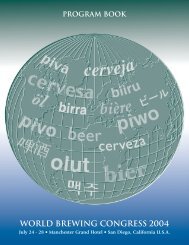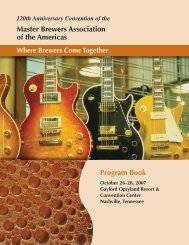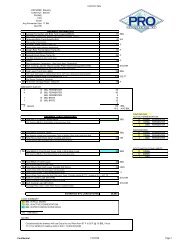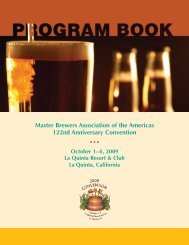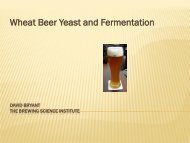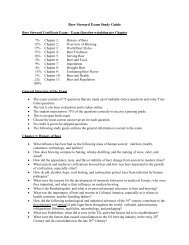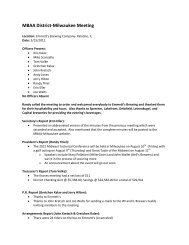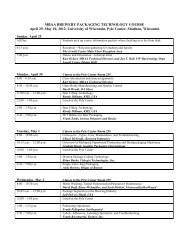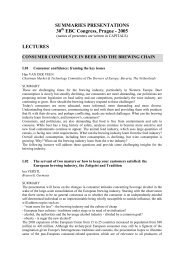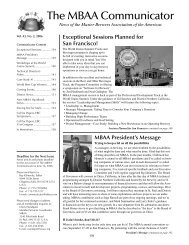Pasteurization Technology
Pasteurization Technology
Pasteurization Technology
Create successful ePaper yourself
Turn your PDF publications into a flip-book with our unique Google optimized e-Paper software.
March 10, 2011<br />
District Michigan<br />
MBAA<br />
Technical Meeting<br />
Grand Ledge, MI
Presentation Agenda<br />
� <strong>Pasteurization</strong> Basics<br />
� Tunnel <strong>Pasteurization</strong> <strong>Technology</strong><br />
� Flash <strong>Pasteurization</strong> <strong>Technology</strong><br />
� <strong>Technology</strong> Comparison<br />
� Questions and Discussion
Theory and Objective of <strong>Pasteurization</strong><br />
� Elevated levels of heat will kill organisms<br />
� Heat beer to arrest biological contamination<br />
� Destroy viability of yeast<br />
� Prevent post fermentation<br />
� Brewers want Pasteurize not Sterilize<br />
� Minimum temperature for target organisms<br />
� Limited <strong>Pasteurization</strong> units
Time and Temperature<br />
Curve<br />
Maintaining the<br />
time/temperature<br />
profile is key to<br />
preserving the<br />
process or<br />
protecting against<br />
under and over<br />
pasteurization
<strong>Pasteurization</strong> – Lethal Effect<br />
� A lethal effect of 1 PU (<strong>Pasteurization</strong> Unit) is<br />
obtained when product can be held at 140F for 1<br />
minute<br />
� Brewers typically target 10PU’s to 15PU’s<br />
� Control of PU’s is essential<br />
� Elevated PU’s can affect flavor degradation
Measuring <strong>Pasteurization</strong> Units<br />
� Measure at “Cold Spot” of container<br />
� Probe position in container<br />
� Pasteurizer internal calculation<br />
� Using sensing devices and programming<br />
� Calculate PU’s<br />
� Time above 120F<br />
� Time in holding tube at <strong>Pasteurization</strong> temperature
Measuring Heat Transmission<br />
Cold Spot is<br />
usually<br />
located at<br />
¼” to 1”<br />
above the<br />
center of the<br />
bottom of<br />
the container<br />
TEMPERATURE °F<br />
140<br />
135<br />
130<br />
125<br />
120<br />
115<br />
110<br />
105<br />
100<br />
95<br />
90<br />
85<br />
80<br />
75<br />
70<br />
65<br />
TIME IN MINUTES<br />
2 4 6 8 10 12 14 16 18 20 22 24 26 28<br />
AVE. TEMP.<br />
COLD SPOT TEMP.<br />
INITIAL BEER TEMP. 40 °F (4.4 °C)<br />
SPRAY AT 140 °F (60 °C)<br />
T00384<br />
60.0<br />
57.2<br />
54.4<br />
51.7<br />
48.9<br />
46.1<br />
43.3<br />
40.6<br />
37.8<br />
35.0<br />
32.2<br />
29.4<br />
26.7<br />
23.9<br />
21.1<br />
18.3<br />
TEMPERATURE °C
Lethal Rate Curve<br />
PRODUCT TEMPERATURE<br />
°C<br />
62.2<br />
61.7<br />
61.1<br />
60.6<br />
60.0<br />
59.4<br />
58.9<br />
58.3<br />
57.8<br />
57.2<br />
56.1<br />
48.9<br />
°F<br />
144<br />
143<br />
142<br />
141<br />
140<br />
139<br />
138<br />
137<br />
136<br />
135<br />
133<br />
Average 12.35 P.U.'s<br />
Cold Spot 8.60 P.U.'s<br />
120 0.025<br />
0 5 10 15<br />
MINUTES<br />
2.09<br />
1.74<br />
1.45<br />
1.20<br />
1.00<br />
0.83<br />
0.69<br />
0.57<br />
0.48<br />
0.39<br />
0.27<br />
LETHAL RATE P. U. 'S / MINUTE<br />
PU’s calculated for<br />
product temperature<br />
above 120ºF.<br />
Area under the curve<br />
equals the number of<br />
PU’s achieved.<br />
Cold spot PU’s less<br />
than Average.
<strong>Pasteurization</strong> Unit Graph<br />
PU / MINUTE =<br />
1<br />
-1<br />
LOG<br />
140 - °F<br />
12.5<br />
(°F - 140)<br />
= 1.20226<br />
PU / MINUTE =<br />
-1<br />
LOG<br />
(°C - 60)<br />
1<br />
60 - °C<br />
6.94<br />
= 1.393<br />
PU / MINUTE<br />
40.0<br />
30.0<br />
20.0<br />
10.0<br />
7.0<br />
5.0<br />
3.0<br />
2.0<br />
1.0<br />
0.7<br />
0.5<br />
0.3<br />
0.2<br />
0.1<br />
TEMPERATURE °C<br />
50 52 54 56 58 60 62 64 66 68 70<br />
0.03<br />
120 130 140 150 160<br />
TEMPERATURE °F<br />
10 PU’s<br />
30 sec<br />
= 157F<br />
10 PU’s<br />
10 min<br />
= 140F
Barry-Wehmiller Advanced PU Limit<br />
System<br />
PU Accumulation<br />
PU Accumulation Rate<br />
120<br />
125<br />
130<br />
135<br />
140<br />
145<br />
150<br />
Product Temperature [deg F]<br />
155<br />
160<br />
165<br />
170<br />
175<br />
1000.00<br />
100.00<br />
10.00<br />
1.00<br />
0.10<br />
0.01<br />
PU / minute
Validating Measurement<br />
� Independent validation for tunnel<br />
� Several manufacturers of independent PU<br />
measuring devices<br />
� Measure time and temperature<br />
� Calculate and report PU values<br />
� Machine internal validation for flash<br />
� Redundancy on sensors<br />
� Micro analysis
Verifying <strong>Pasteurization</strong><br />
Independent<br />
measurement is<br />
capable with tunnel<br />
technology only.<br />
Redundancy can<br />
help reliability
Types of Beer <strong>Pasteurization</strong> <strong>Technology</strong><br />
Two basic types of beer pasteurization<br />
1. Tunnel <strong>Pasteurization</strong><br />
2. Flash <strong>Pasteurization</strong>
Tunnel Pasteurizer
Tunnel Pasteurizer Overview<br />
� General Description<br />
� Pasteurizer Features<br />
� Pasteurizer Systems<br />
� Operational Controls<br />
� Reporting/Recording
Pasteurizer – General Description<br />
� Length - Width<br />
� # of Decks<br />
� Features<br />
� Systems
Pasteurizer Features<br />
� End Casings<br />
� Removable<br />
Top Covers<br />
� Container<br />
Water Blow-<br />
Off<br />
� Condensate<br />
Return System
Pasteurizer Process Systems<br />
� Regeneration Capability<br />
� Heating System<br />
� Belt and Drive System<br />
� Spray System<br />
� Pump Systems<br />
� PU Control<br />
� Controls, Alarms
Tunnel Pasteurizer Regeneration<br />
Cold containers<br />
entering require heat<br />
Hot containers exiting<br />
require cooling<br />
Zoning<br />
Set Point Balance<br />
Maximum Regen<br />
Compensation<br />
Exit Temperature
Single Heat Exchanger System<br />
Single Heat Exchanger with plate Heat Exchanger.<br />
Closed Loop System with hot water available on<br />
demand.
Basic Concepts<br />
Single Heat Exchanger System<br />
� Benefits of the Single Heat<br />
Exchanger System<br />
� Low Maintenance<br />
� Only one heat exchanger<br />
� Plate Heat exchanger<br />
� Efficient use of energy<br />
� Condensate return<br />
� Less Pump<br />
Horsepower required
Typical Heat Exchanger Skid – Large<br />
Machine
Pasteurizer Main Belt<br />
� Intralox 400 and 1900 with<br />
Enduralox<br />
� Twentebelt Combinox and<br />
Eyelink<br />
� Regina 3120<br />
� Rexnord 5997 with DTS-C
UHMW Wear Strip Attachment<br />
Allow for UHMW expansion<br />
Easy install and replacement
Main Drive SEW Motor/gearbox
Spray and Pump System<br />
� Pressurized water flow rate<br />
designed to optimize thermal<br />
heat transfer rates<br />
� Up to 6.8gpm/ft²<br />
� Thermal Dynamic Models<br />
� Manual Blow Downs<br />
� Even flow across the deck<br />
� Predictable Heat Transfer<br />
� Removable spray headers<br />
� 3 1/2” header, 3/8” nozzles
Spray System Filter<br />
Screens<br />
Redundancies for Maintaining Spray Consistency<br />
� Belt side guides<br />
� Belt mesh pattern<br />
� Dual pump inlet screens<br />
� Spray header design<br />
� Spray header blow down
Filter Screen External Access Doors
Spray System Blow Down
PU Limiting<br />
� Hot Zones<br />
� Add cold water<br />
to zone reservoir<br />
� Re-heat on start<br />
up
Advanced PU Control System<br />
� Advanced PU Control System controls the<br />
pasteurization process:<br />
� Guarantee very tight PU control<br />
� Preserve the process curve in stop/start<br />
conditions<br />
� Move process to container if container can not<br />
get to process
Possible to have hot water on<br />
one header and cold water on<br />
another header from the same<br />
manifold
Utility Control <strong>Technology</strong> ‘IntelliFlow’<br />
� The IntelliFlow System:<br />
� Used in conjunction with Advanced PU Control<br />
� Water temperature separation technology<br />
� Eliminates requirement for water re-heating<br />
� Provides benefits of PU control without added<br />
utility consumption
Pasteurizer Control Items<br />
� Sensors, proximity switches, instruments<br />
� Safeties and Alarms
Pasteurizer Safety and Alarms<br />
� Hot zone pumps 2º below set point for 30 seconds<br />
will stop belt<br />
� Pressure sensors all zones below 2psi for 15<br />
seconds stops pasteurizer<br />
� All levels satisfied before pasteurizer will start<br />
� Belt speed monitored by checking starwheel pulse<br />
duration to time set in recipe<br />
� Drive overloads – spring and proximity
Pasteurizer Recording Capability<br />
� Data collected from Sensors:<br />
� Temperature of all zone sprays<br />
� Speed of belt<br />
� Levels<br />
� Data collected in the pasteurizer PLC<br />
� Data sent to remote storage<br />
� Data can be extracted to workable files<br />
� Reports can be generated
Flash Pasteurizer<br />
Volutherm Series<br />
Flash Pasteurizer
Flash <strong>Pasteurization</strong><br />
� <strong>Pasteurization</strong> occurs prior to filling<br />
� Short Time High Temperature (HTST)<br />
� Heat Exchanger (plate or tube)<br />
� Fixed or Variable flow rates<br />
� <strong>Pasteurization</strong> calculated by Holding Time and<br />
Temperature<br />
� High Efficiency (90% regeneration)<br />
� Controls are Key!
Flash Pasteurizer 180 Hl/Hr
Flash Pasteurizer 320 Hl/Hr
Flash Pasteurizer 360 Hl/Hr<br />
Flexibility to design<br />
units to fit various<br />
applications<br />
Juice unit with Heat<br />
Exchanger mounted<br />
on the floor for<br />
accessibility on<br />
larger pasteurizers<br />
Often times machines<br />
can be designed to<br />
handle different<br />
products on the same<br />
unit
Flash Pasteurizer – 250 Hl/Hr
Flash Pasteurizer Features<br />
� Constant PU Variable Flow rate Unit.<br />
� Pressure Balance System.<br />
� 90% Energy Recovery.<br />
� Status and Process Alarms.<br />
� Digital Paperless Chart Recorder.<br />
� Fully Automatic Operation.
Flash Pasteurizer Design
Flash Pasteurizer<br />
Components
Product Flow Meter<br />
An Electromagnetic flow measuring system is used to monitor the flow of the<br />
product at the discharge of the pasteurizer.
Product Flow Control Valve<br />
(Detail View)<br />
4-20mA Electrical Input Signal.<br />
Resulting in a 0-100% Valve opening.
Product Temperature Measurement<br />
PT100 Temperature probes monitor the temperature of the fluids<br />
Within the pasteurizer.<br />
As the temperature changes the resistance measured by a<br />
Transmitter fitted inside the temperature probe changes.<br />
The input signal to the pasteurizer control system is electronic<br />
4 – 20mA.
Product Temperature Control<br />
Pressure Reducing Valve<br />
A pressure reducing valve is designed for<br />
maintaining the pressure downstream of the steam<br />
supply valve to an adjusted set point value.<br />
Set point approximately 2.0bar<br />
The valve closes when the downstream<br />
pressure rises.<br />
Pneumatic Control Valve<br />
The hot water that is used to raise the beer to the<br />
required pasteurization temperature is heated using<br />
steam controlled by the pneumatic controlled valve.<br />
This valve uses a pneumatic control signal to adjust<br />
The amount to which it opens and so the amount of<br />
steam that can flow into the plate pack
Process Recording<br />
� Touch Screen HMI<br />
� Select recipes<br />
� Operational functions<br />
� Adjust parameters<br />
� Alarm displays<br />
� Digital Paperless Process Logger<br />
� Records temperatures<br />
� Records flow rates<br />
� Records pressures<br />
� CIP and Run modes
Process Recording<br />
�Temperatures<br />
�Pressures<br />
�Calculated PU’s<br />
�Production / CIP Flow rate<br />
�Production / CIP / SIP Mode<br />
�Product In Machine
Central System Operation
Central System Operation
Flash Pasteurizer – Benefits and Features<br />
� Performance tolerance to with in 1PU<br />
� Variable flow, variable temperature<br />
� Maximum regeneration<br />
� Quality monitoring, alarms, reports, archiving<br />
� Machine self-diagnostics<br />
� Operation safe-guards for PU protection<br />
� Gentle product handling (HTST)<br />
� Compact footprint, Low energy use
PROCESS COMPARISONS
Process Comparison Factors<br />
� Application Issues<br />
� Operational Issues<br />
� Quality Issues<br />
� Economic Issues<br />
� Equipment Issues
Application Issues<br />
� Tunnel<br />
� Wide range of products<br />
� Carbonated or non-carbonated<br />
� Container limitations<br />
� Flash<br />
� Wider range of products<br />
� Product limits for plate and frame<br />
� Carbonated or non-carbonated
Operational Issues<br />
� Tunnel<br />
� Controls and Complexity can be less<br />
� More forgiving<br />
� Reduced requirement for micro control<br />
� Manual machine cleaning<br />
� PU Control required for line conditions<br />
� Flash<br />
� Cleaning and Sanitation Increased<br />
� Line availability reduced<br />
� Enhanced microbiological testing<br />
� CIP systems are critical<br />
� Buffer systems for handling line conditions
Quality Issues<br />
� Tunnel<br />
� Taste affects possible with prolonged stops<br />
� Validation using independent device<br />
� Reduced requirement for micro control<br />
� Exit temperatures<br />
� Flash<br />
� Minimal taste affects<br />
� Potential for recontamination<br />
� Validation – trust sensors, redundancy<br />
� Ability to re-circulate<br />
� Disinfecting caps and containers – filler contact points
Economic Issues<br />
� Tunnel<br />
� High capital costs for new equipment and installation<br />
� Operating costs can be high<br />
� Reduced costs for monitoring quality<br />
� Increased line utilization<br />
� Flash<br />
� Capital cost can include warmer, filling room upgrades<br />
� High efficiency reduces utility cost (warmer?)<br />
� Less floor space required
Example Comparison for Flash and Tunnel<br />
� Example Selection:<br />
� Brewery<br />
� Bottle production line operating at 800bpm<br />
� Target PU’s at 10 +/- 2<br />
� Target BOT at 75°F
Example Comparison for Flash and<br />
Tunnel<br />
� Equipment Cost<br />
Flash Process Tunnel Process<br />
Volutherm 200B –<br />
$300,000<br />
Buffer Tank - $50,000<br />
Warmer - $375,000<br />
Clean Room – $275,000<br />
Total equipment -<br />
$1,000,000<br />
New Double Deck sized<br />
correctly to optimize utility<br />
consumption and provide low<br />
product exit temperatures<br />
- $1,500,000
Example Comparison for Flash and<br />
Tunnel<br />
� Utility Consumption<br />
Flash Process Tunnel Process<br />
Volutherm 200B<br />
New Double Deck Tunnel<br />
Water - 140 gal/chase out Water - 0gpm, running mode<br />
Steam – 8,000 btu/min<br />
- 100gpm run-out<br />
BWCo Warmer<br />
24mins<br />
Water – 0gpm normal Steam – 20,000 normal run<br />
Steam - 31,500btu/min<br />
- 72,000 start-up<br />
Total Steam -39,500 Avg. steam - ~<br />
btu/min<br />
35,000btu/min
Example Comparison for Flash and<br />
Tunnel<br />
� Floor space requirement<br />
Flash Process Tunnel Process<br />
Volutherm 200B – 200 sq. ft.<br />
Buffer tank and valves stand<br />
- 80 sq. ft.<br />
Warmer 826 SD<br />
- 280 sq. ft.<br />
Total - 480 sq. ft.<br />
New Double Deck Tunnel<br />
1120 sq. ft.
Summary of Process Comparison<br />
� Capital Cost – Similar when considering clean room<br />
� Utility Consumption – Similar when using warmer<br />
� Process Considerations – Culture change for flash<br />
� Cleaning Materials/Sanitizing Agents and Micro<br />
Control requirements – Higher costs for flash<br />
� Available Packaging Line Time – Higher for tunnel<br />
� Floor Space – Flash has reduced space requirement
Time for a beer….<br />
�Thanks for listening!



